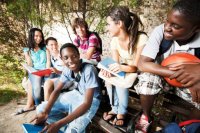Building Social and Emotional Skills in Elementary Students: So Similar
This is part eight of the nine-part series from the Project Happiness curriculum. We are looking at important factors that influence the happiness and social and emotional learning of elementary school age children, helping students learn life skills, manage emotions, and increase empathy. Each blog features one letter of the acronym HAPPINESS:
- H = Happiness
- A = Appreciation
- P = Passions and Strengths
- P = Perspective
- I = Inner Meanie/Inner Friend
- N = Ninja Mastery
- E = Empathy
- S = So Similar
- S = Share Your Gifts
In this post, we will explore recognizing what we have in common.
I recently visited Watershed School in Boulder, Colorado, which specializes in Project-Based and Experiential Learning. Over a brown-bag lunch with students and teachers, I was invited to talk about happiness: how we can learn to take charge of our happiness, and how to increase it to be more productive and engaged both in school and in life. Interpersonal connection is a big part of happiness, and the Project-Based Learning model fosters it well. I was struck by how the students treated each other with:
- An understanding of what was similar for everyone
- Respect for their differences
- Appreciation for other students and teachers alike
Pass the Pulse and Appreciations
After our time together, the students at Watershed School stood in a circle and did an activity called "pass the pulse." Everyone held hands, and as one person received a squeeze (pulse) in their right hand, she or he would move the pulse along by squeezing her or his left hand, passing the pulse to the next person in the circle. It was considered an honor to begin the activity -- the individual who initiated the pulse was someone that the whole group recognized as a positive leader that week. Though the whole thing only took a moment or two, this built a sense of group cohesiveness that was palpable.
Next, both students and teachers did what they called "appreciations," in which they spontaneously spoke of the people or situations that they appreciated during the past week. Consider trying this in your class! It was amazing to witness their positivity, consideration for each other, and teamwork in action.
Social Connections
How we connect socially a big contributor to happiness and productivity. What contributes directly to the feeling of connectedness and acceptance is the understanding that, on some very core human levels, we are more similar than we may know. At the same time, we are also different; and not only is that OK, but it's also something to respect and even honor.
In The Whole-Brain Child, Drs. Daniel Siegel and Tina Payne Bryson explain, "Just as its many different parts are made to work together, each individual brain is made to relate with the brain of each person we interact with." They use the phrase "interpersonal integration" to describe the process of honoring and nurturing our differences while cultivating our connections with one another.
Global Literacy
As modern technology creates an ever more connected world, we are all becoming more interdependent. For students to thrive with 21st century skills, it can no longer be an "us vs. them" conversation. Universal traits are important to recognize. This is true in our own back yard right now with issues like bullying, and equally important as students enter a more global workplace later in life. If they are taught from a young age that, at their core, people everywhere share a desire to be loved, to belong, to matter and to be respected, they will have a basis for better and more compassionate relationships. Further, their acceptance of others will increase as they learn that it's a good thing there are many variations in people (such as hair color, eye color, type of food or sports we prefer, holidays we celebrate, etc.). The benefits of teaching students that, now more than ever, it's time to honor our differences while acknowledging our shared humanity include:
- An understanding that they are never alone in their feelings, because all humans are "So Similar" at our core
- Promoting diversity consciousness so they are less resistant to or afraid of people who are different
- Fostering the values of cooperation and teamwork, as a student in a classroom and a citizen of the world
Happiness, Teamwork and Productivity
On the subject of teamwork, happiness is an important advantage in creating successful group activities. Because happiness, like all emotions, is contagious, it can permeate a group, a class, or even an entire school community. Studies of sports teams have found that even "one happy player was enough to infect the mood of the entire team, and that the happier the team was, the better they played." By focusing on positivity, recognizing our similarities, and honoring our differences, we set the stage for kids to thrive in a myriad of settings. I was inspired to see these principles in action.
Find lesson plans and additional resources at projecthappiness.org. And please answer these questions in the comments section below: What have you tried in your class? What obstacles have you faced? What changes would you like to see?
